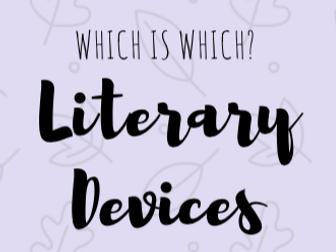Exploring the Magic of Literary Devices
Hudson Miles (hudsonmiles)
on
June 5, 2023
Add a comment about this article!
Exploring the
Interplay of Onomatopoeia, Oxymorons, and
Satire in Literary Works
�
�
Introduction
Literature is a remarkable platform for
creative expression and storytelling. Writers
often employ various literary devices to
captivate readers, evoke emotions, and convey
their messages effectively. Three prominent
devices in this regard are onomatopoeia, oxymorons,
and satire.
�

�
These devices not only add depth and
complexity to the narrative but also engage
readers in unique ways.
In this article, we will delve into the
interplay of onomatopoeia, oxymorons, and
satire in literary works, exploring their
definitions, functions, and examples.
�
Onomatopoeia: Words That Echo
Onomatopoeia refers to the use of words
that mimic or resemble the sounds they
describe. Through onomatopoeic words, writers
create vivid auditory experiences for
readers, immersing them in the world of the
narrative.
For instance, words like "buzz," "hiss,"
or "crash" convey specific sounds, allowing
readers to visualize and hear the events
unfolding in the story. Onomatopoeia adds a
layer of sensory detail and realism to the
text, enhancing the overall reading
experience.
�
Oxymoron: Juxtaposing Contradictions
An oxymoron is a figure of
speech that combines contradictory terms
within a single phrase or sentence. This
literary device aims to create a paradoxical
effect and provoke deeper contemplation.
Oxymorons often highlight the complexities
of human nature or the contradictions
inherent in certain situations. They serve as
a powerful tool for emphasizing contrasts,
evoking irony, and challenging conventional
wisdom. Phrases such as "bittersweet,"
"living dead," or "cruel kindness" exemplify
the intriguing nature of oxymorons.
�
Satire: Humor with a Purpose
Satire is a genre of literature that uses
humor, irony, and sarcasm to criticize and
expose human follies, vices, or societal
shortcomings. Writers employ satire to raise
awareness, provoke thought, and effect
change.
Through cleverly crafted narratives,
satirical works aim to entertain while making
a larger point about the flaws and
absurdities of the world we inhabit. Satire
can be found in various forms, including
novels, plays, and satirical cartoons,
offering a rich and diverse literary
tradition.
�
The Interplay of Onomatopoeia, Oxymorons,
and Satire
While onomatopoeia, oxymorons, and satire
serve different purposes individually, their
interplay within literary works can produce
powerful effects. By combining these devices,
writers can create nuanced narratives that
engage readers on multiple levels.
Let's explore some examples to understand
their combined impact.
In a satirical novel, the author might use
onomatopoeic words to amplify the comedic
effect of certain scenes. For instance,
describing a comical mishap with exaggerated
sound effects can heighten the absurdity of
the situation, eliciting laughter from the
readers.
The interplay of onomatopoeia and satire
allows writers to create memorable moments
that linger in the readers' minds.
Similarly, oxymorons can be used in
satirical works to highlight the inherent
contradictions or hypocrisies of certain
characters or institutions.
By juxtaposing contradictory terms,
writers can expose the irony and flaws in
societal norms or individual behavior. The
combination of oxymorons and satire provides
a powerful tool for social critique and
commentary.
Furthermore, onomatopoeia can enhance the
impact of oxymorons within a literary work.
By creating a vivid soundscape through
onomatopoeic words, writers can accentuate
the contrasts and contradictions expressed in
oxymoronic phrases.
This combination deepens the reader's
engagement with the text and emphasizes the
underlying themes or messages.
�
Examples from Literary Works
To fully grasp the significance of
onomatopoeia, oxymorons, and satire, let's
explore examples from renowned literary
works:
-
Onomatopoeia: In Edgar
Allan Poe's poem "The Bells," the use of
onomatopoeic words such as "tinkle,"
"jingle," and "clang" creates a distinct
auditory experience, symbolizing different
stages of life and death.
-
Oxymoron: Shakespeare's
play Romeo and Juliet features the famous
line, "O brawling love! O loving hate!" Here,
the oxymoron "loving hate" encapsulates the
contradictory nature of the characters'
emotions and the conflicts they face.
-
Satire: Jonathan Swift's
novel Gulliver's Travels is a classic example
of political satire. Swift employs humor and
satire to critique various aspects of
society, including politics, science, and
human nature.
�
These examples illustrate how these
devices contribute to the richness and depth
of literary works, enabling writers to convey
their messages effectively and engage readers
in thought-provoking ways.
�
Conclusion
Onomatopoeia, oxymorons, and satire are
powerful literary devices that elevate
storytelling and enrich the reader's
experience. The interplay of these devices
within literary works creates layers of
meaning, engages readers on multiple levels,
and allows writers to convey their messages
with impact.
Whether it is the vivid auditory imagery
of onomatopoeia, the thought-provoking
contradictions of oxymorons, or the biting
social commentary of satire, these devices
leave a lasting impression on readers.
By understanding and appreciating the role
of these devices in literature, readers can
deepen their engagement and gain a deeper
appreciation for the craft of writing.
Remember, the next time you encounter an
onomatopoeic word, stumble upon an oxymoron,
or find yourself laughing at a satirical
work, you are witnessing the brilliance of
these literary devices in action.
So, embrace the interplay of onomatopoeia,
oxymorons, and satire, and let them transport
you into the captivating realm of literature.
If you need assistance with your essay,
visit write my essay�for
professional writing help and guidance.
�
�
Other literary devices you should
know:
Writing with Flair: How to Use
Hyperbole, Imagery, and Metaphor to Create an
Essay that Stands Out
Unleashing the Power of
Hyperbole, Imagery, and Metaphor: A
Masterclass in Expressive Writing
The Trifecta
of Language: Hyperbole, Imagery, and Metaphor
in Captivating Writing
The Art of Expression:
Hyperbole, Imagery, and Metaphor in
Mesmerizing Writing
I'm sorry, this Article is unavailable or waiting for administration approval and therefore no comments are allowed.
|

